Sigma 1835mm F18 Dc Hsm Art Standard Zoom Lens Weight
Sigma 18-35mm f/one.8 DC HSM Art Lens Review

The word "groundbreaking" seems inadequate for describing the awesomeness of the Sigma eighteen-35mm f/1.viii DC HSM Art Lens. The chief reason for that awesomeness is the not-seen-in-any-other-zoom-lens f/1.8 aperture. In fact, f/one.8 is 1 1/3 stops wider/faster than the adjacent-widest/fastest f/2.8 zoom lens crowd – assuasive more than twice as much light to reach the camera sensor than the tied-for-second place lenses. The f/1.8 max aperture, available over the unabridged focal length range, puts this zoom lens on a shelf by itself. Per Sigma, information technology is a world'due south outset.
Just because a lens has a specific max aperture does not mean that you lot volition want to use that aperture, but this lens rocks at f/1.8. Combine excellent wide open image quality with a great looking, great performing and modest fixed-sized package along with a good price and you accept a lens that is going to find a abode in MANY kits. The downsides? A relatively short focal length range and lack of image stabilization are the just ones on my list.

Let's start the review with a look at the focal length range equally that is ane of my primary criteria for lens selection. Yous demand the focal length that is going to let proper framing and proper perspective for your subjects. The "DC" ("Digital Photographic camera") in the name means that this lens is uniform only with ASP-C/ane.6x FOVCF sensor format DSLR cameras. My APS-C format general purpose lens minimum focal length range recommendation is 18-45mm, which relates to 28.8-72mm in full frame format.
The Sigma 18-35mm f/i.8 DC HSM Art Lens' focal length range covers simply a subset of my recommended range – equating to a 28.eight-56mm angle of view on a full frame photographic camera. That this lens does non meet my minimal focal length range desires for a general purpose lens is going to be overlooked by most – this range demand beingness commencement by the low lite and background blurring capabilities made possible by the f/1.8 max discontinuity.
Being long on the broad finish and short on the long end, 18-35mm still works well for many landscape photography uses. While landscape photography does non so-frequently need the f/i.8 aperture advantage this lens holds, the right weather atmospheric condition (very overcast to eliminate hotspots with some rain to drive abroad other visitors – and add saturation), a sweet loaner machine (my machine was in the shop) and this lens needing a workout provided far more motivation than I needed to schedule a day trip to Ricketts Glen State Park. From this location comes this review's focal length range examples.

The Sigma 18-35mm f/i.8 DC HSM Art Lens is one of the showtime members of Sigma'due south Global Vision Lens lineup. Global Vision lenses receive designations of "A" for Art, "C" for Contemporary or "South" for Sports. While I'one thousand loving what Sigma is doing with their lenses right now, I'm not yet a fan of limiting the usefulness of a lens to one of these categories (and what does "Contemporary" mean for a lens designation? Will information technology notwithstanding be gimmicky in 10 years? Are the "A" and "South" lenses not just as contemporary?).
The 18-35 f/1.8 wears an "A" bluecoat. And I'yard certain that the wide "A"perture is largely responsible for this classification. Wide apertures mean shallow depth of field. Shallow depth of field can mean that the subject pops from a blurred groundwork. Blurring the groundwork is of course easiest at longer focal lengths – and 35mm is not a very long focal length.
The prototype below shows a 35mm f/1.8 example focused at approximately six' (ane.8m). Click on the image to see a consummate 18mm and 35mm aperture comparison. Y'all may exist surprised at how in-focus-appearing the groundwork appears at 18mm f/one.eight in a 650px high size-reduced image.

The bottom line is that the f/one.8 aperture enables a more-strongly blurred groundwork than that f/2.8 zoom alternative you were considering (identical focal lengths compared).
While I suppose that any image tin can be classified as fine art, my definition for art imagery is far narrower – and this lens has far broader usefulness than my definition's limitations. The mural photography use I mentioned above is only the tip of the iceberg for this lens' complete usefulness list.
Information technology seems that I am finding a new utilize for this lens every day. I've had the 18-35 mounted to my 60D and available for immediate use since it arrived over 2 weeks ago. It has been a great selection for capturing the daily memories of life. Some examples of which you will notice throughout this review.
The 18-35mm focal length is rather wide bending for most sports needs, but this lens certainly tin can exist used for the narrow niche of athletic activities these focal length piece of work for. The f/1.8 aperture is extremely desirable for sports captures – especially the indoor varieties. Near-court basketball photography for example.
Capturing an indoor or other low low-cal people issue? This lens is a adept pick.
With few exceptions, every lens can be used as a portrait lens. Merely not every lens is good for all types of portraits. The perspective required for tight 18-35mm portraits make this lens a bad choice for such – unless you want to get "artistic". Notice the big nose and small hands in the sample motion picture below? This lens will be better-used for half-torso and more than-loosley cropped portraits – and for grouping portraits.
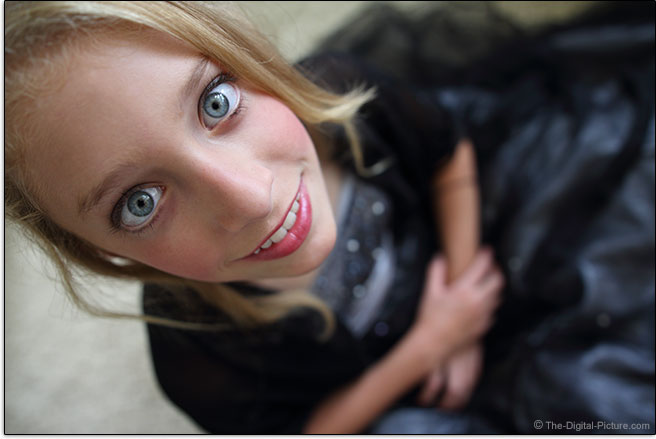
The above epitome was captured at 18mm, f/1.8 using a Canon EOS 60D at a not-kind-for-faces close focus distance. The 100% crop provides a glimpse of the abrupt image quality this lens delivers at f/1.8. That performance is from a very low DPP sharpness setting of "2" – the everyman setting I regularly use with the 60D.
Another cistron making the relatively short focal length range more palatable is the image quality this lens delivers. Particularly at f/i.8 where this lens delivers very practiced sharpness across the entire frame. Sharpness is slightly better at the wide end than the long end, just f/1.8 real life images from both ends look skillful. Stopping down to f/2.8 volition improve sharpness modestly, but you are going to have difficulty seeing the f/two.eight to f/4 difference in your images. The 35mm corners capeesh a narrower aperture the most.
Ofttimes, wide aperture lenses used on the largest sensor format photographic camera they support, bear witness significant amounts of vignetting – which negates some of the broad aperture advantage. This lens breaks that stereotype. It is not vignetting free, but the one.4 to 1.6 stops of corner vignetting at f/1.8 is relatively mild for an f/one.eight lens. By f/four, the peripheral shading is substantially gone.
A wide angle lens with a wide discontinuity, sharp beyond-the-frame wide open aperture image quality and low vignetting begs to be used for night sky photography. And this lens is a practiced selection for such use.

Stars in the corner of a frame tend to bring out another lens aberration – coma. Coma turns your piffling circular stars into Martian infinite ships. I'grand happy to report that the 18-35 shows only slight effects from coma in only the extreme frame corners.
The Sigma 18-35 shows some CA (Chromatic Aberration) in the corners at the broad end of the focal length range. Very little CA remains at 24mm.
I mentioned that rain chases visitors abroad from land parks. A significant storm non showing on the radar arrived all of a sudden not long after arriving at Ricketts Glen SP. Though the 18-35 is not waterproof, I was prepared for rain. Only, with the car being still close by and the rain too hard to shoot through, I went for embrace. But lens testing never stops.

This control dial in the automobile is monochrome. The extra colors are not supposed to be there. What you are seeing is often referred to as bokeh CA – CA that shows in the out of focus portions of the image. This anomaly will just be noticeable in like shooting situations.
Wide angle focal lengths make information technology more hard to get a blurred background, only wide apertures make it easier. The Sigma 18-35mm f/1.viii DC HSM Art Lens has both. Every bit can exist seen in the dial control image above, this lens tin create a very potent blur at 35mm if the subject area is close and the aperture is broad. Apply a more-afar background to create more groundwork blur.
Zoom out and cease the lens down (narrower aperture – higher aperture number) and creating a background blur becomes more difficult. Just it can still be done. Here is an 18mm f/5.6 example.

From this example, we can meet that the 9-blade aperture delivers rather smoothen out of focus highlights with a touch of vivid edge. The blur quality in my real life applications has been dainty.
With the sunday in the corner of the frame, the Sigma 18-35 shows very fiddling flare from a wide open up f/1.8 aperture. Flare slowly increases every bit the aperture narrows until becoming noticeable at f/8 and by f/16, strong flaring is obvious.
Most 16, 17 or 18mm-to-something-mm lenses evidence very noticeable barrel baloney at their widest focal length. This lens has barrel baloney at 18mm, only it performs meliorate than many similar lenses by showing merely a modest amount. As usual, the barrel baloney is corrected every bit the focal length increases until essentially being gone at effectually 22mm. Pincushion distortion then creeps into the picture and becomes mild from 28 through 35mm.
Overall, I am very pleased with the image quality from this commencement-e'er lens pattern. It has a green light for my own needs.
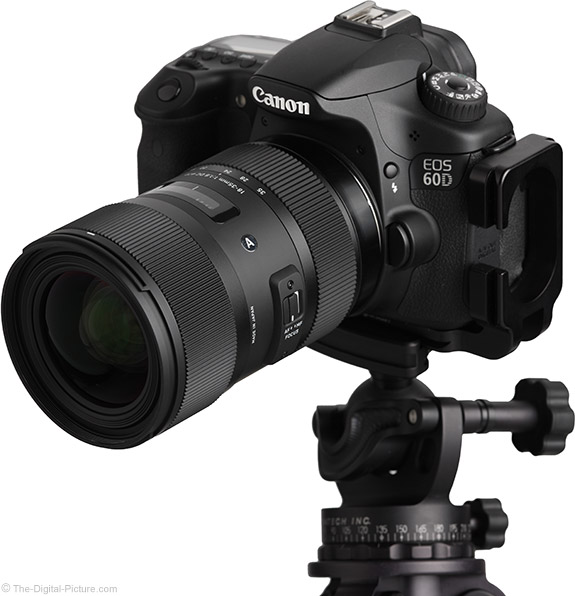
Featuring Sigma's HSM (Hypersonic Motor) driven AF, the Sigma eighteen-35mm f/1.viii DC HSM Art Lens focuses with very practiced speed. It is not the fastest-focusing lens made, but it is far from the slowest. Focusing is very tranquillity with only some clicks existence heard every bit last focus adjustments are nailed down.
This is an internally-focusing lens with FTM (Full Time Manual) focusing available. Filters installed on this lens will not rotate during focusing.
Great for video recording is that subjects do not change size with focusing. They go into and out of focus of course, merely they do not grow or compress while doing then. The image remains solidly-centered during focus changes.
At short distances, this lens is practically parfocal (focus distance settings remains the same throughout the zoom range). Longer distance focusing likes more focus aligning through the bachelor focal length range. Sigma provides equally many focus distance markings as can reasonably exist fit into the infinite bachelor for them in the window.
This lens is compatible with the Sigma Dock. The USB dock allows the lens' firmware to be updated (bug fixes, compatibility updates, etc.) and allows precise focus scale. On the exam charts and using the Datacolor SpyderLensCal, the 18-35 f/1.8 focused very accurately with excellent consistently. Check out the five focus accuracy test samples below.

1 | 2 | three | 4 | 5
You don't run across any difference between those images? No difference is what y'all want to see. And the "0" is where the sharpest focus should be. The were xv other identical images, only I couldn't meet the indicate of boring y'all with the balance of the samples.
In the field, AF has been performing very well, but not perfectly. I did find occassional AF misses. Especially when working virtually this lens' MFD (Minimum Focus Distance).

I know – deplorable well-nigh the creepy subject. Sometimes these situations only autumn into my lap. My married woman, using her unmistakable slightly panicked phonation, called me to our finished basement to eradicate this little monster. Upon arrival on the scene, I decided that the 3.25" (82.5mm) Wolf Spider would brand a not bad subject.
As I said before, the Sigma 18-35 has been a great lens to have available for effectually-the-business firm use and has been glued to my 60D since information technology arrived. I grabbed it, a Catechism 600EX-RT Speedlight, a Speedlite Transmitter ST-E3 RT and a small softbox and returned to the scene of the dwelling invasion. Every bit I gathered the gear, the stress level was being increased equally my wife learned that I had left the hairy creature alive and unattended.
Fortunately, the spider remained findable. Since the carpet was not the background I wanted, I slid a piece of printer newspaper under it. That was of course much easier to say than to exercise.
The above picture was captured at the 18-35's minimum focus distance. The residue of the photo details: 35mm, ISO 100, f/8.0, 1/160. I released the spider exterior as the carpet would accept needed cleaning if I had squished it as requested.
At MFD, one shot AF was backfocusing a loftier pct of the fourth dimension. But, with the Sigma Dock and SOP app, this issue is correctable. Autofocus can be in-lens calibrated for four focus distances at 18mm, 24mm, 28mm and 35mm.
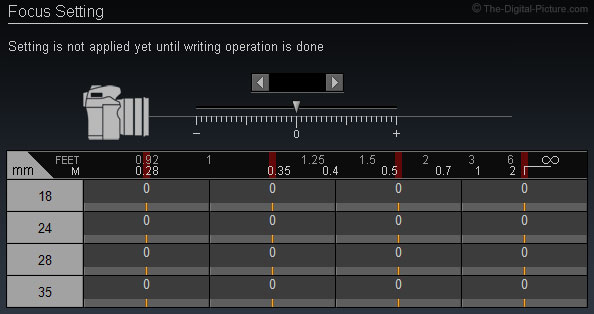
Wider focal lengths make fast-action subjects suitable for safety for tight framing difficult to find, only I did find the 18-35 f/i.8'southward AI Servo AF to perform reasonably well in such circumstances.
This lens' 0.23x MM (Maximum Magnification) specification is decent – quite good compared to the f/ii.viii zoom lenses containing similar focal lengths. The spider image above examples 0.23x. Of course, from a high resolution camera, a subject captured at 0.23x magnification tin be printed or displayed at many times life size. The chart below shows the referenced comparison with the f/2.eight zoom lenses.
| Model | MFD | MM | |
| Catechism EF 16-35mm f/ii.viii L Ii USM Lens | xi.0" | (280mm) | 0.22x |
| Canon EF-S 17-55mm f/2.8 IS USM Lens | thirteen.8" | (350mm) | 0.16x |
| Sigma 17-50mm f/2.viii EX DC Bone HSM Lens | 11.0" | (280mm) | 0.20x |
| Sigma xviii-35mm f/1.8 DC HSM A Lens | xi.0" | (280mm) | 0.23x |
| Tamron 17-50mm f/2.eight XR Di Ii Lens | 10.6" | (270mm) | 0.22x |
| Tamron 17-50mm f/2.8 XR Di 2 VC Lens | eleven.4" | (290mm) | 0.21x |
| Tokina sixteen-28mm f/2.8 AT-Ten Pro FX Lens | 11.0" | (280mm) | 0.19x |
Need more magnification? Extension tubes are your best option as this lens is non uniform with Sigma's extenders.
The images below bear witness all of the available APS-C and larger format DSLR zoom lenses with an discontinuity wider than f/ii.8.

That's right – there is only one.
All of the review-time-current Sigma Global Vision lenses have a really nice concrete appearance with a feel that at least equals the look. The high quality look matches nicely with the loftier quality build of these lenses.
The Sigma 18-35mm f/1.8 DC HSM Fine art Lens has very smooth, perfectly-damped and ideally-sized zoom and focus rings that have no play in them. Annotation that the zoom ring rotates in the Nikon standard direction (opposite of Canon's standard zoom ring rotation direction). Only the ribbed condom surface portion of the zoom band extends beyond the lens barrel diameter and the frontward-positioned (where I want it) focus ring is raised just slightly more the lens barrel, for an overall smooth pattern that feels great in mitt.
This lens is slightly narrow and slightly long relative to other lenses in its form. If you lot can telephone call any other lens in the same class. For lack of better options, I list the xvi, or 17mm-to-something f/ii.eight zoom lenses for comparison.
| Model | Weight | Dimensions w/o Hood | Filter | Year | ||
| Canon EF sixteen-35mm f/ii.8 L Ii USM Lens | 22.half-dozen oz | (640g) | 3.5 x 4.4" | (88.5 x 111.6mm) | 82mm | 2007 |
| Canon EF-Southward 17-55mm f/2.8 IS USM Lens | 22.8 oz | (645g) | 3.iii x 4.4" | (83.five x 110.6mm) | 77mm | 2006 |
| Sigma 17-50mm f/2.eight EX DC OS HSM Lens | 19.9 oz | (565g) | iii.three x 3.six" | (83.5 x 91.8mm) | 77mm | 2010 |
| Sigma 18-35mm f/1.8 DC HSM A Lens | 28.6 oz | (811g) | 3.1 ten 4.viii" | (78 x 121mm) | 72mm | 2013 |
| Tamron 17-50mm f/2.8 XR Di Two Lens | xv.3 oz | (434g) | 3.2 x 2.9" | (81.7 x 74mm) | 67mm | 2006 |
| Tamron 17-50mm f/2.viii XR Di II VC Lens | xx.1 oz | (570g) | three.i ten 3.7" | (79.vi ten 94.5mm) | 72mm | 2009 |
| Tokina 16-28mm f/two.8 AT-X Pro FX Lens | 33.5 oz | (950g) | 3.5 ten 5.2" | (90 ten 133.3mm) | n/amm | 2011 |
For many more than comparisons, review the consummate Sigma eighteen-35mm f/one.8 DC HSM Art Lens Specifications using the site's Lens Spec tool.
The somewhat dense weight in a modestly-sized, quality-built package gives the 18-35mm f/1.8 lens a solid feel. Every bit recently introduced with the Sigma 120-300mm f/2.8 DG OS Sports Lens, Sigma utilizes Thermally Stable Composite (TSC) materials in the build of this lens. TSC combines the characteristics of metal and polycarbonate and has the thermal expansion/contraction backdrop of aluminum. "Since thermal shrinkage is low, [TSC] has a loftier affinity to metallic parts ..." and permits size reduction in other mechanical parts including the zoom ring. TSC too has a considerably higher elasticity compared to Sigma's other products.
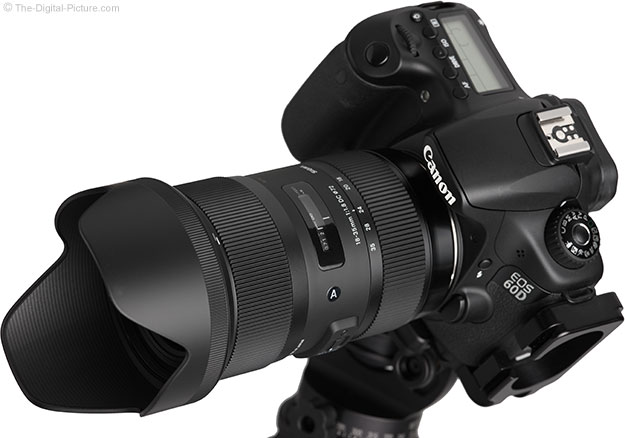
Annotation that this is not a weather-sealed lens.
The 72mm filter size is a common one. These filters are not as well big or too pricey. I can run across only a very slight corporeality of vignetting being caused by a standard thickness CP filter at 18mm f/1.eight.

Positioned above from left to correct in their fully retracted positions are the following lenses:
Sigma 17-50mm f/two.8 EX DC Os HSM Lens
Catechism EF-S 17-55mm f/2.8 IS USM Lens
Canon EF 16-35mm f/two.eight L 2 USM Lens
Sigma 18-35mm f/i.eight DC HSM Art Lens
The aforementioned lenses are shown beneath in their fully extended states with their lens hoods in place.
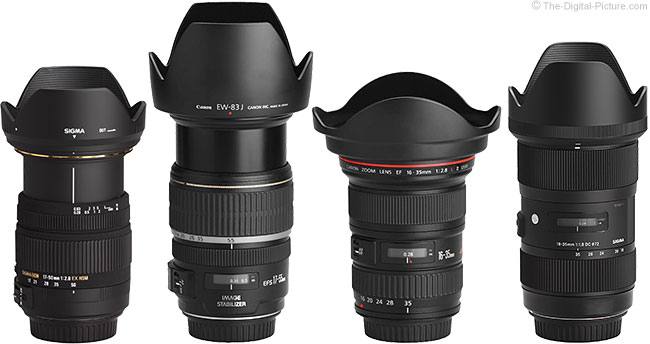
The Sigma eighteen-35 has an attractive, clean, slender, polish design that, if I haven't fabricated it clear already, I like a lot.

As with all Sigma lenses, the lens hood is included in the box. The rear of this modestly-sized hood has a rubberized surface that makes it easy to grasp for bayonet installation/removal. Sigma's recently improved lens cap design is also like shooting fish in a barrel to grasp for installation or removal.

Sigma includes a nice padded, zippered nylon instance in the box. The case has a i.75" (440mm) chugalug loop for attaching to a slim belt (or narrow thick belt).
Want to know what yr your lens was fabricated? With a Sigma Global Vision lens, determining the reply to this question is very easy – just prefix a "2" to the iii-digit number engraved near the lens mount.

The Sigma 18-35mm f/1.8 DC HSM Art Lens is bachelor in Catechism (reviewed), Nikon, Pentax, Sony/Minolta and Sigma mounts. Changing photographic camera brands? Sigma has announced their "Mount Conversion Service" to protect your investment.

My standard disclaimer: There are potential issues with 3rd party lenses. Since Sigma reverse engineers (vs. licenses) manufacturer AF algorithms, there is e'er the possibility that a DSLR body might not support a (likely older) third party lens. Sometimes a lens tin can be made uniform past the manufacturer, sometimes not. In that location is also the chance of a problem that results in the lens and body manufacturers directing blame at each other. Compatibility with the Sigma Dock is risk reducing. Sigma USA'southward 3-year warranty is superior to Catechism's standard 1 twelvemonth warranty (Sigma's international warranty is also one year).
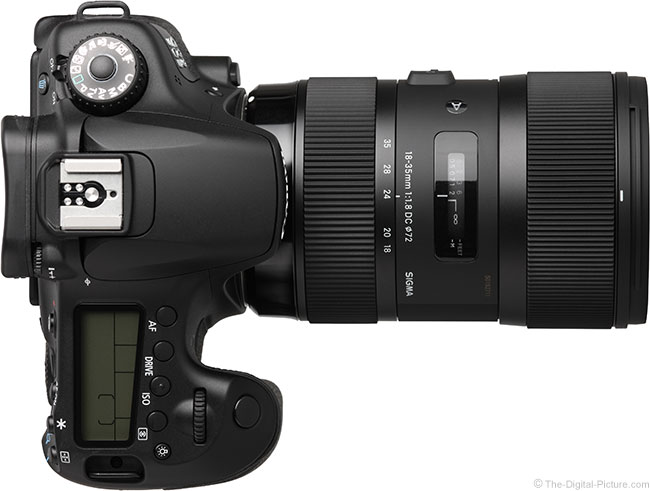
I see this lens equally having two limitations. The first is the lack of optical stabilization. Sigma stated the "Information technology already was a tough challenge for the states to develop a high-spec lens with F1.8 throughout its zoom range. This time, our commencement priority [was] to accomplish the 1.8 constant aperture. Incorporation of OS function [will] exist our next footstep."
The f/1.8 aperture reduces the need for Bone in scenarios where the reduced depth of field work is adequate (or preferred). The f/2.8 zoom lenses with optical stabilization are handholdable in fifty-fifty lower lite levels when the discipline is non moving.
The other limitation I see in the xviii-35 f/one.viii is the limited focal length range relative to the other APS-C-just 17 or 18mm to something zoom lenses. When asked if the limited focal length range design was necessary to proceed the lens size manageable and the price affordable, Sigma responded: "Increasing the focal range and maintaining the optical performance seen in the eighteen-35mm 1.eight would exist a claiming, more so than cost or size but Sigma will continue to push button the boundaries on what lenses can do." The latter is certainly going to be interesting.
It is easy to overlook any focal length range deficiencies when getting an f/1.8 max aperture available over the unabridged focal length range. Not only is this the widest aperture zoom lens, but it is also the widest aperture 18mm lens. Full frame sensor camera owners have typically enjoyed virtually 1 finish of high ISO noise benefit and background blurring capability over APS-C/1.5x/i.6x format sensor camera owners. But, full frame camera owners do non have a zoom lens wider than f/ii.8 available to them. The Sigma 18-35mm f/one.8 DC HSM "Art" Lens is a fleck of an equalizer in this comparison.
While this lens is designed to comprehend only an APS-C-sized camera sensor, this lens mounts and functions on a total frame DSLR. And the vignetting is not every bit bad equally you lot might expect. Here is a all-time-instance example:

Cheque out the consummate full frame comparison to become the entire moving picture.

I'm not ready to give upward my full frame bodies, but ... I'm loving this lens. The great image quality seals the bargain for the Sigma 18-35mm f/1.viii DC HSM Art Lens. The results that this lens is capable of delivering are impressive.
Bringing you this site is my full-time job (typically 60-80 hours per calendar week). Thus, I depend solely on the commissions received from you using the links on this site to brand whatever purchase. I am grateful for your back up! - Bryan
My Recommended Sigma 18-35mm f/i.8 DC HSM Fine art Lens Retailers
Hire the Sigma eighteen-35mm f/ane.viii DC HSM Art Lens
The Tip Jar
Bryan Recommends Buying It Here
Source: https://www.the-digital-picture.com/Reviews/Sigma-18-35mm-f-1.8-DC-HSM-Lens.aspx
0 Response to "Sigma 1835mm F18 Dc Hsm Art Standard Zoom Lens Weight"
Postar um comentário